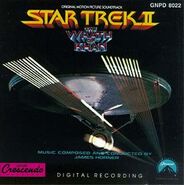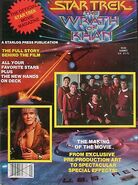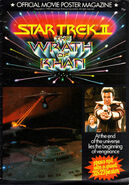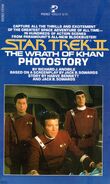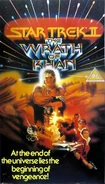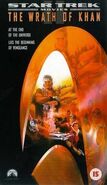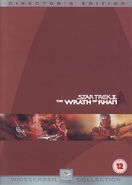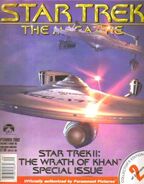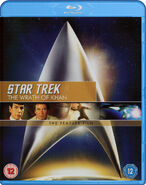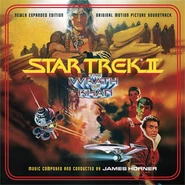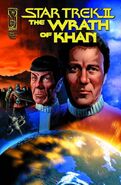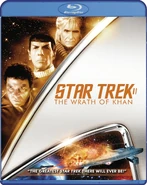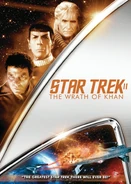| Line 53: | Line 53: | ||
Outside the [[Mark IV bridge simulator|simulator room]], [[Spock]] awaits Kirk's opinion of the [[cadet]]s' performance. Kirk notes that the trainees wreaked havoc with the simulator room and Spock alike. Spock recalls Kirk's own ''Kobayashi Maru'', noting that the Admiral took the test three times and that his final solution was somewhat "unique." Kirk then thanks Spock for his [[birthday]] present, an antique copy of ''[[A Tale of Two Cities]]''. |
Outside the [[Mark IV bridge simulator|simulator room]], [[Spock]] awaits Kirk's opinion of the [[cadet]]s' performance. Kirk notes that the trainees wreaked havoc with the simulator room and Spock alike. Spock recalls Kirk's own ''Kobayashi Maru'', noting that the Admiral took the test three times and that his final solution was somewhat "unique." Kirk then thanks Spock for his [[birthday]] present, an antique copy of ''[[A Tale of Two Cities]]''. |
||
| − | Kirk then retreats to his |
+ | Kirk then retreats to his apartment, to be greeted by [[Leonard McCoy]], who presents him with a bottle of finely-aged [[Romulan ale]]. Noticing Kirk is acting stranger than usual, he questions whether Kirk really wants to carry on the duties of an admiral, or to be "hopping galaxies" in a starship. Kirk confesses it to him, and the two share a drink sitting by the fireplace. |
:"''Starship log, stardate 8130.4. Log entry by First Officer Pavel Chekov. Starship ''Reliant'' on orbital approach to Ceti Alpha VI in connection with Project Genesis. We are continuing our search for a lifeless planet that will satisfy the requirements of a test site for the Genesis experiments. This is the sixteenth planet we have visited. So far, no success.''" |
:"''Starship log, stardate 8130.4. Log entry by First Officer Pavel Chekov. Starship ''Reliant'' on orbital approach to Ceti Alpha VI in connection with Project Genesis. We are continuing our search for a lifeless planet that will satisfy the requirements of a test site for the Genesis experiments. This is the sixteenth planet we have visited. So far, no success.''" |
||
Revision as of 04:28, 3 February 2012
Template:Realworld "KKKHHHHHAAAANNNNN!!!!!!!!!!!!!!!!"
"At the end of the universe lies the beginning of vengeance."
Admiral James T. Kirk faces his greatest challenge yet. Suffering through doubts about his place in the galaxy, he is thrust into action once more against his most bitter foe–Khan Noonien Singh, who has escaped his exile on Ceti Alpha V and now seeks revenge on Kirk. With a powerful new device in the wrong hands, and a no-win scenario in play, the cost of victory for the Starship Enterprise may prove too high.
Summary
IN THE 23RD CENTURY...
- "Captain's log, stardate 8130.3. Starship Enterprise on training mission to Gamma Hydra. Section 14, coordinates 22-87-4. Approaching Neutral Zone, all systems normal and functioning."
A female Vulcan sits in the command chair on the bridge of the Enterprise. While the senior crew work at their consoles, the officer, Saavik, makes a log entry, then orders Commander Sulu to project a course to avoid entering the Neutral Zone.
Suddenly, Uhura receives a distress call from the Kobayashi Maru, which has struck a gravitic mine near Altair VI... inside the Neutral Zone. Despite warnings from both Sulu and Spock, Saavik orders the ship to enter the Zone in order to beam the survivors aboard. Upon entering the Zone, the Enterprise is confronted with three Klingon battle cruisers, which open fire. The Enterprise is heavily damaged; many of the bridge officers are killed. Saavik has no alternative but to order the surviving crew to abandon ship.
Then the filtered voice of Admiral Kirk is heard. The bridge viewscreen slides aside, revealing a lighted room beyond. The Kobayashi Maru was a test – one Saavik does not believe to have been a fair test of her abilities. Kirk explains that the no-win scenario is a situation every commander may face, and that how one faces death is equally important as how one faces life. Saavik seems ruffled at the advice, but Kirk offers that now she has something new to think about.
Outside the simulator room, Spock awaits Kirk's opinion of the cadets' performance. Kirk notes that the trainees wreaked havoc with the simulator room and Spock alike. Spock recalls Kirk's own Kobayashi Maru, noting that the Admiral took the test three times and that his final solution was somewhat "unique." Kirk then thanks Spock for his birthday present, an antique copy of A Tale of Two Cities.
Kirk then retreats to his apartment, to be greeted by Leonard McCoy, who presents him with a bottle of finely-aged Romulan ale. Noticing Kirk is acting stranger than usual, he questions whether Kirk really wants to carry on the duties of an admiral, or to be "hopping galaxies" in a starship. Kirk confesses it to him, and the two share a drink sitting by the fireplace.
- "Starship log, stardate 8130.4. Log entry by First Officer Pavel Chekov. Starship Reliant on orbital approach to Ceti Alpha VI in connection with Project Genesis. We are continuing our search for a lifeless planet that will satisfy the requirements of a test site for the Genesis experiments. This is the sixteenth planet we have visited. So far, no success."
Meanwhile, Commander Chekov is on board the USS Reliant, which orbits Ceti Alpha VI in connection with Project Genesis, searching for a lifeless planet to satisfy the requirements of a test site for the Genesis experiment. Although Ceti Alpha VI should be incapable of supporting life, Chekov detects a minor energy flux reading on one dynoscanner. Chekov and Captain Terrell beam down to the surface to investigate. Upon arrival, they fight their way through clouds of dust until they discover and enter what appears to be a crashed derelict vessel.
They soon discover that the derelict is a shuttlecraft from the SS Botany Bay, a ship Chekov remembers all too well. Panicking, he rushes a confused Terrell toward the exit, only to find that a group of people are waiting outside. Their captor reveals himself as Khan Noonien Singh, and it further turns out that the planet they are investigating is in fact Ceti Alpha V, which was devastated by the explosion of the sixth planet shortly after Khan and his followers were marooned on the planet by Kirk decades ago. In order to find out why the two are there, Khan forces juvenile Ceti eels into their ears, rendering them subservient to his every command. Khan and his followers subsequently take control of the Reliant, and Khan's second-in-command, Joachim tries to convince Khan that by escaping the planet, he has now evened the score with Kirk. Khan is not content to merely be equal with Kirk however, and is determined to fully avenge himself on the Admiral.
Under the command of now-Captain Spock, the Enterprise is being used to train Starfleet Academy cadets, and Kirk, McCoy, Uhura, and Sulu come aboard to assist in a short training cruise. But Khan lures Kirk to research station Regula I, by having Chekov inform Dr. Carol Marcus, head of the Genesis project, that Kirk has ordered them to take possession of the Genesis Device. A furious Dr. Marcus attempts to contact Kirk to confirm the order, but the signal is jammed by Khan, with only bits and pieces of the message going through. Kirk, after consulting with Starfleet Command, converses with Captain Spock, who encourages Kirk to assume command. Kirk protests, insisting that it is okay for Spock to retain command during the mission, but Spock assures Kirk that he has no ego to be bruised by Kirk taking over for him, and further asserts that it was a mistake for Kirk to accept promotion, as commanding a starship is Kirk's first, best destiny. Kirk assumes command and orders Enterprise to set a course for Regula I.
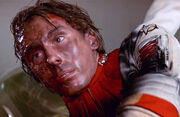
Peter Preston, mortally wounded by Khan's attack
Enterprise finds the Reliant waiting for them. Despite being unable to contact Reliant, Kirk is reluctant to raise shields – as, Saavik reminds him, regulations prescribe. Reliant opens fire, knowing exactly where its weak points are, disabling the Enterprise's Main Energizer and Warp Core, leaving only the battery to power the ship, and mortally injuring several cadets. Engines are down, shields inoperative, and there is only enough power for a few phaser shots, which isn't enough against Reliant's shields.
Khan hails Kirk, who is shocked to see Khan in command of the Reliant. Khan arrogantly announces his plans to destroy the Enterprise, to which Kirk pleads with Khan to take him as prisoner and spare his crew. Khan agrees, but also demands all information on the Genesis device. Kirk pretends to comply, but actually transmits a signal using Reliant's prefix code (1-6-3-0-9) that causes Reliant to lower her shields. Despite Khan's intelligence – he knew exactly where to hit the Enterprise for maximum damage effects – he is still relatively inexperienced with a starship. When he realizes what Kirk is doing he is unable to immediately locate the controls to override the command lowering the shields. With the few shots auxiliary power can give him, Kirk is able to fire at the Reliant, damaging photon control and the warp drive. Khan is reluctant to withdraw, but Joachim reminds him that Enterprise, with its disabled power systems, can't escape. Both ships limp away for repairs and the match ends in a stalemate.

The Enterprise at Regula I
Kirk surveys the wounded in sickbay and attends Midshipman 1st Class Peter Preston on his deathbed. With impulse power restored, the Enterprise arrives at Regula I. Kirk assembles a landing party, and Saavik reminds him of General Order 15 barring him from beaming into a dangerous situation without armed escort. They find the station's crew killed, and discover Chekov and Terrell semi-conscious inside a storage compartment. They find that the stations records of the Genesis Device have been erased by the Regula staff. Exploring the station leads them to a transporter that has recently been activated. Checking the coordinates, Kirk realizes they beamed into the Regula asteroid. Kirk asks for a damage report from Enterprise. Spock reports that "by the book, hours would seem like days" and that transporters will be available in two days.
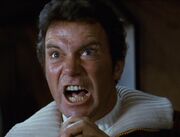
"Khaaaaaaaaan!!"
They follow the transporter coordinates and materialize inside a chamber. The Genesis Device is there, but before Kirk can move, he is attacked by his son, David Marcus, who accuses Kirk of trying to steal Genesis. Carol, David's mother, tries to defuse the situation, but before she can elaborate, the team is threatened by Chekov and Terrell. The Genesis Device is beamed away and Terell is ordered by Khan to kill Kirk. Terrell, however, resists Khan and the eel causes him extreme pain. To escape it he turns his phaser on himself and is vaporized. Chekov collapses and the Ceti eel slurps out of his ear, before being vaporized by Kirk. Khan, shocked to find Kirk alive and well, vows to leave him marooned on Regula for eternity, causing Kirk to scream at Khan in (seeming) rage.
Kirk avoids Carol and David's questions about Khan by asking for food. Carol and David show Kirk, McCoy and Saavik the Genesis cave, which was created by a smaller Genesis Device: deep within Regula a stable ecosystem now exists having been created in one day. In the cave, Saavik asks Kirk, who is casually eating an apple, about his performance on the Kobayashi Maru scenario. McCoy tells her that Kirk is the only one to beat the no-win scenario and Kirk admits he reprogrammed the simulation. David chuckles and says he cheated, and Kirk qualifies that he "changed the conditions of the test." Kirk then promptly contacts Enterprise and Spock says they should prepare for transport. Kirk smiles at a dumbfounded Saavik and asserts that he doesn't like to lose. Saavik questions what happened throughout the transport and Kirk reminds her of Regulation 46A: Spock had modified his report to deceive Khan.
Unfortunately, the ship cannot outrun or outgun the far less damaged Reliant. Kirk decides to take refuge in the nearby Mutara Nebula, whose ionized gases disrupt the sensors and shields of both vessels. Khan orders Reliant to pursue, but his crew is reluctant, as they know the shielding and sensor systems will be rendered useless.
Back on the Enterprise, Spock notes in his sensors that Reliant is reducing speed and seems to be backing away from the pursuit. To ensure that Khan will follow him, Kirk has Uhura contact Reliant and proceeds to taunt his nemesis, saying "We tried it once your way, Khan. Are you game for a rematch? Khan ... I'm laughing at the superior intellect." Enraged by the mockery, Khan orders full impulse power and despite Joachim's protests, recklessly launches into the pursuit again. Then, the Battle of the Mutara Nebula ensues. Both ships are quite hampered by the conditions, but this is a good thing for Kirk, since both ships are reduced to an equal level of non-functioning systems, whereas in open space Enterprise would have been the more disabled vessel.
A game of cat-and-mouse follows. Computer targeting does not function, so both crews must rely on manual firing commands based on their view of the opposing ships on the visual display, which is mostly static. Sulu, being more experienced, is able to make better guesses and inflict slight damage but both vessels mostly miss each other.
As they maneuver half-blind around the nebula, suddenly the static on the Enterprise screen clears enough to reveal that the ships are about to collide. They veer apart and narrowly miss colliding, and at such point-blank range even manual firing is sufficient for each vessel to inflict key hits on the other. The Reliant manages to destroy the port torpedo launcher of the Enterprise, which then returns fire and damages the Reliant bridge module, causing an explosion that kills several of the ship's bridge crew including Khan's most trusted lieutenant, Joachim, whom Khan vows to avenge.
Kirk is nevertheless able to beat Khan because of his superior starship combat experience. A shaken, but physically recovered, Chekov enters the bridge and offers his assistance. Khan, thinking on a 2-dimensional scale, isn't prepared for Enterprise to head "down" as he passes overhead and then come back "up" directly behind him. Reliant is hit with several phaser blasts, and a torpedo breaks off its port nacelle. Reliant is crippled and drifts away, trailing plasma. Most of Khan's crew is killed in the process, and Khan himself is left crippled and barely alive.
In a final attempt to kill Kirk, Khan activates the Genesis Device. The Enterprise is too damaged to escape the large explosion that the device will trigger. Unnoticed, Spock exits the bridge, while Kirk orders a withdrawal at "best possible speed". On Reliant's bridge, Khan quotes Moby Dick observing: "No, Kirk, you can't get away. From hell's heart, I stab at thee. For hate's sake I spit my last breath at thee." Seconds later he succumbs to his injuries and dies.
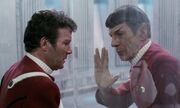
"I have been... and always shall be... your friend."

"He's really not dead... as long as we remember him."
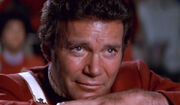
"It is a far, far better thing I do than I have ever done before. A far better resting place that I go to than I have ever known."
Spock arrives in engineering, only to be stopped by Dr. McCoy from entering a lethally irradiated compartment that is part of the warp drive system. After initially appearing to comply with McCoy, an apologetic Spock incapacitates McCoy, and mind melds with the doctor, saying "Remember..." He then dons work gloves, enters the chamber, and repairs the main reactor.
The warp engines come on line just in time, and Enterprise streaks away just as the Genesis Device explodes. The Mutara Nebula condenses around the explosion, creating the Genesis Planet. Kirk contacts Engineering to congratulate Scotty, but McCoy gravely replies that Kirk needs to come down, which is when Kirk notices the empty chair at the science station. A look of complete horror fills Kirk's face as he rushes down to Engineering to find Spock, dying. Kirk calls out for Spock and follows as the Vulcan, blinded by the radiation, staggers to the side of the transparent radiation barrier, finally resting against it.
Spock attempts with difficulty to explain to Kirk his reasoning: "Do not grieve, Admiral. It is logical. The needs of the many outweigh ..." to which Kirk replies, "the needs of the few," and Spock nods. "Or the one ..." Spock states that he himself never took the Kobayashi Maru simulation "until now," and asked Kirk, "What do you think of my solution?"
Kirk, stricken with grief, can't reply. "I have been and always shall be your friend. Live long and prosper." He holds out his hand, in the traditional Vulcan salute, and Kirk presses his hand up to the glass as well, watching as Spock slumps to the floor, and expires. It takes all of his resolve to keep his composure as he sees his closest friend die in front of him. This time, there is no going back.
Spock's funeral is held later, on the torpedo deck. Kirk says a few words in Spock's honor, concluding with a befitting statement: "Of all the souls I have encountered in my travels, his was the most... Human." Among the strains of Amazing Grace on the bagpipe, Spock's body is launched in a torpedo casing into the atmosphere of the newborn Genesis Planet.
Some time after the funeral, Kirk is in his quarters and tries to read from the book Spock gave him but discovers that one of the lenses of his reading glasses was broken during the final battle with Reliant. Exasperated, he tosses them on the table as David enters. Kirk tries to be dismissive but David confronts him, telling Kirk that he (Kirk) never really faced death. When Kirk admits that he hasn't, David points out that Kirk earlier told Saavik that how people face death is as important as how they face life. Kirk says those were just words, but David thinks they were good words, from which good ideas come. He then tells Kirk he is proud to be Kirk's son. The two of them hug, awkwardly at first but then with genuine warmth.
- "Captain's log, stardate 8141.6. Starship Enterprise on course for Ceti Alpha V to pick up the crew of the USS Reliant. All is well. And yet I can't help wondering about the friend I leave behind. There are always... possibilities, Spock said. And if Genesis is, indeed, life from death, I must return to this place again."
Later, on the bridge, Dr. McCoy, Carol Marcus and Kirk stare at the Genesis Planet on the main viewscreen as the Enterprise departs for Ceti Alpha V to pick up the surviving crew of the Reliant.
Kirk softly quotes the last lines of A Tale of Two Cities; something Spock was trying to tell him on his birthday. Upon McCoy's inquiry as to how Kirk feels, he answers: "Young. I feel young."
The movie closes with the panning over jungle flora (presumably on the Genesis Planet), briefly pausing to show the torpedo casing containing Spock's body which has landed on the planet, as Spock's voice provides the final words of the film:
Space...the final frontier. These are the continuing voyages of the Starship Enterprise. Her ongoing mission: to explore strange new worlds...to seek out new life forms, and new civilizations...to boldly go where no man has gone....before.
Memorable Quotes
"Any suggestions, Admiral?"
"Prayer, Mister Saavik. The Klingons don't take prisoners."
- - Saavik and Kirk, after the Kobayashi Maru exercise
"Physician, heal thyself."
- - Kirk, to McCoy
"How we deal with death is at least as important as how we deal with life, wouldn't you say?"
- - Kirk, to Saavik
"Galloping around the cosmos is a game for the young, Doctor."
- - Kirk, to McCoy
"Aren't you dead?"
- - Kirk, to Spock
"What beams you into this neck of the woods?"
"Beware Romulans bearing gifts. Happy birthday, Jim."
- - Kirk and McCoy
"Jim, I'm your doctor and I'm your friend. Get back your command. Get it back before you turn into part of this collection. Before you really do grow old."
- - McCoy, referring to Kirk's collection of antiques
"Jim Kirk was many things, but he was never a boy scout!"
- - Carol, to David
"What the hell happened? If they crashed, then where's the rest of the ship?"
- - Terrell, on the Botany Bay
"I never forget a face, Mister... Chekov, isn't it."
- - Khan
"Chekov, who is this man?"
"A criminal, Captain. A product of late twentieth century genetic engineering."
- - Terrell and Chekov, on Khan
"On Earth, two hundred years ago, I was a prince with power over millions."
"Captain Kirk was your host. You repaid his hospitality by trying to steal his ship and murder him!!"
- - Khan and Chekov
"These are pets, of course. Not quite domesticated."
- - Khan, on the Ceti eels
"Gishen worla ihk-banut. (He's never what I expect.)"
"Wakli ak'wikman - ot-lan? (What surprises you, lieutenant?)"
"Ish-veh ni... komihn. (He's so... human.) "
"Kling akhlami buhfik - Saavik-kam. (Nobody's perfect, Saavik.)"
- - Saavik and Spock, on Kirk
"As a physician, you of all people should appreciate the danger of re-opening old wounds."
- - Kirk to McCoy, on talking with Carol
"Starfleet has kept the peace for over a hundred years; I cannot and will not subscribe to your interpretations of this event!!"
- - Carol, to David
"I am a Vulcan. I have no ego to bruise."
- - Spock, on handing over the Enterprise to Kirk
"Commanding a starship is your first best destiny. Anything else is a waste of material."
- - Spock, to Kirk
"Were I to invoke logic, logic clearly dictates that the needs of the many outweigh the needs of the few."
"Or the one."
- - Spock and Kirk
"You are my superior officer. You are also my friend. I have been and always shall be yours."
- - Spock, to Kirk
"So much for the little training cruise."
- - Sulu, after the Enterprise is diverted to Regula I
"I'll chase him round the moons of Nibia and round the Antares maelstrom and round perdition's flames before I give him up!"
- - Khan to Joachim, paraphrasing Moby Dick
"Well, put simply, Genesis is life from lifelessness."
- - Carol's summary proposal on the Genesis Project
"As a matter of cosmic history, it has always been easier to destroy than to create."
- - Spock
"According to myth, the Earth was created in six days. Now, watch out! Here comes Genesis! We'll do it for you in six minutes!"
- - McCoy
"Let them eat static!"
- - Khan, as the Enterprise requests communications
"Do you know the Klingon proverb that tells us revenge is a dish that is best served cold? It is very cold in space."
- - Khan, before attacking the Enterprise
"Sir, you did it!"
"I did nothing! Except get caught with my britches down."
- - Sulu and Kirk, after the Enterprise retaliates
"He wants to kill me for passing sentence on him 15 years ago, and he doesn't care who stands between him and his vengeance."
- - Kirk, on Khan
"Jim, be careful."
"WE will."
- - Spock and McCoy, before Kirk, McCoy and Saavik beam over to the space lab
"Suppose they went nowhere."
"Then this'll be your big chance to get away from it all."
- - McCoy and Kirk, before beaming into the Regula I cavern
"Mother, he killed everybody we left behind!"
"Of course he didn't. David, you're just making this harder."
"I'm afraid it's even harder than you think, Doctor. Please...don't move."
- - David, Carol and Terrell
"All is well, sir. You have the coordinates to beam up Genesis."
"First things first, Captain. Kill Admiral Kirk."
- - Terrell and Khan
"You've managed to kill just about everyone else, but like a poor marksman, you keep missing the target!"
- - Kirk, taunting Khan
"Khan, you've got Genesis. But you don't have me. If you're going to kill me, Khan, you're gonna have to come down here. You're gonna have to come down here!!"
- - Kirk, taunting Khan
"I've done far worse than kill you. I've hurt you, and I wish to go on hurting you. I shall leave you as you left me. As you left her. Marooned for all eternity in the center of a dead planet. Buried alive. Buried alive!"
"Khan!!! Khan!!!"
- - Khan and Kirk
"You had your world and I had mine. And I wanted him in mine, not chasing through the universe with his father."
- - Carol to Kirk, on David
"Can I cook or can't I?"
- - Carol, on the vegetation in the Genesis cave
"I don't believe in a no-win scenario."
- - Kirk to Saavik, on why he cheated on the Kobayashi Maru test
"That young man, he's my son."
"Fascinating."
- - Kirk and Spock, on David
"He's intelligent, but not experienced. His pattern indicates two-dimensional thinking."
- - Spock, on the Reliant's movements
"No, Kirk. The game's not over. To the last I will grapple with thee!"
- - Khan, as he activates the Genesis Device
"Are you out of your Vulcan mind? No human can tolerate the radiation that's in there."
"As you are so fond of observing, Doctor, I'm not human."
- - McCoy and Spock, outside the engineering compartment
"I'm sorry, Doctor, I have no time to discuss this logically. Remember."
- - Spock to McCoy, as he mind-melds with him
"From hell's heart, I stab at thee. For hate's sake I spit my last breath at thee."
- - Khan's last words
"Jim, I think you'd better get down here."
- - McCoy, as Kirk realizes that Spock is missing
"Sir, he's dead already."
- - Scott on Spock, as he and McCoy restrain Kirk
"I have been ... and always shall be ... your friend. Live long ... and prosper."
- - Spock's dying words to Kirk
"Of all the souls I have encountered in my travels, his was the most ... human."
- - Kirk, eulogizing Spock
"I've cheated death. I tricked my way out of death and patted myself on the back for my ingenuity. I know nothing."
- - Kirk, to David
"I was wrong about you, and I'm sorry."
"Is that what you came here to say?"
"Mainly. And, also, that I'm ... proud, very proud to be your son."
- - David and Kirk
"He's really not dead. As long as we remember him."
- - McCoy, on Spock
"How do you feel?"
"Young. I feel young."
- - McCoy and Kirk, as they look at the Genesis planet
Analysis
The screenplay for Star Trek II was written by director Nicholas Meyer, compiled from a number of drafts which all contained one or several dominant themes. One element was clearly going to be central to the audience's emotional response. Meyer explained: "Once you decide that you're going to have the death of Spock, then how does that affect the other people? Why is it there? I got a lot of stick from a lot of people from the very beginning about the idea of killing Spock. Somebody said, 'You can't kill him.' And I said, 'Sure you can; the only question is whether you do it well.' If his death proceeds organically from the theme and the story of the movie, then nobody's even going to notice it until it's on you, and no one will question it."
In other words, Meyer was determined that his film would be about something, and would do more than tell an adventure story. "We were giving birth to planets, and Kirk was meeting his son, and Spock was dying. You sort of looked at that and said, 'Well, what unifying ideas are running through here?' And then you thought, 'Ah! This is going to be a movie about...'"
Age

Meyer decided to embrace the idea that the characters had aged, and he gave Kirk some very Human flaws, including imperfect eyesight
"This was going to be a story in which Spock died, so it was going to be a story about death, and it was only a short hop, skip, and a jump to realize that it was going to be about old age and friendship. I don't think that any of those other scripts were about old age, friendship, and death."
- "Jim, I'm your doctor and I'm your friend. Get back your command. Get it back before you turn into part of this collection. Before you really do grow old."
- - "Bones" McCoy
The decision that the film was going to be about old age and friendship prompted Meyer to include a scene in which McCoy visits Kirk in his apartment and tells him that he should get his command back. With every alteration, the themes were woven tighter and tighter into the script.
Ultimately, the film presented an aged Kirk in mid-life crisis. Uncertain of his place, of himself, Kirk must make the greatest sacrifice to find out where he truly belongs.
Kobayashi Maru
- "I got a commendation for original thinking. I don't like to lose. [...] I don't believe in the no-win scenario."
- - Kirk, to Saavik
In one of the early drafts for the film, the Kobayashi Maru test was suggested as a no-win scenario – one Nicholas Meyer decided Kirk had solved by cheating. Initially, producer Harve Bennett was resistant to the idea that Kirk could do anything 'bad', yet Meyer won him over; in fact, he believed the story needed Kirk to have flaws. "There's a distinction to be made between heroes and gods," he explained, "which I think we sometimes get confused about. [...] let me explain my theory of heroism. If a man jumps into a raging torrent to save a drowning child, he performs an heroic act. If the same man jumps into the same torrent to save the same child, but does so with a ball and chain attached to his leg, he's not less heroic; he's more heroic."

"How we deal with death is at least as important as how we deal with life..."
"If you look at the heroes of antiquity and myth, they all have flaws. It's something that they have to overcome; their flaws are something that they have to act in spite of. The challenge is not to defy your fate, but to endure it. That is heroic." James T. Kirk is very much like a classical hero who must confront his own weaknesses. He played God when he marooned Khan to a desert world; he chose not to be involved in his son David's life; he allowed Enterprise to be damaged because he would not listen when Saavik told him to raise shields. When Spock dies, Kirk must endure, and Nicholas Meyer was absolutely conscious of this when he was writing the script.
"The flaw is always the same," he explained. "The hero always thinks he knows the answer, and ultimately he learns that he doesn't. [...] There is always a point in Greek plays, known as 'peripatea', where the hero learns that everything he knew is wrong. And it's no accident that in at least two of my movies there comes a point where the hero says, 'I know nothing.' H.G. Wells says it in Time After Time; Kirk says it in Star Trek II. It's when you begin to realize that you know nothing that you're ready to learn something. When you've had the shit kicked out of you, you're ready to start over, and with a little humility. As I was writing it, I was certainly getting to that 'I know nothing' point."
- "I've cheated death, tricked my way out of death, and patted myself on the back for my ingenuity. I know nothing."
- - Kirk
Vengeance
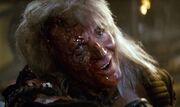
To Meyer's mind, Khan was related to Satan, who fell from grace with God. Of course, thematically, this linked him with Genesis – another of the film's Biblical allusions
- "Ah, Kirk, my old friend, do you know the Klingon proverb that tells us revenge is a dish that is best served cold? It is very cold in space."
- - Khan
Using the original series episode "Space Seed" as a building block, Meyer built Khan into the ultimate adversary for Kirk. As he worked on his character, he imagined how enraged a man would be after being exiled on a desert world and losing his wife. Inevitably, Khan became obsessed with Kirk, who he saw as his nemesis. "Kirk was the fiend who had imprisoned him; who had stopped him up in the bottle. I think when Khan makes his appearance in the story, Kirk is flabbergasted. He did not lie awake thinking about Khan; Khan lay awake thinking about Kirk."
- "Khan!"
- "You still remember, Admiral... I cannot help but be touched. I, of course, remember you."
- - Kirk and Khan
Meyer decided that while Khan had been waiting for a chance to avenge himself upon Kirk, he would have been reading. "I started thinking, 'What books does a superman take with him into exile?' At one point, Khan says, 'On Earth I was a prince,' and certainly he's a fallen angel, so I picked all the books that were Lucifer-related – fallen angel – whether it was 'Moby Dick' or 'Paradise Lost' or 'King Lear', and began to build from there. I thought, 'He's probably been obsessively reading these books again and again until every word out of his mouth has been written by Shakespeare or Milton.' Actually, Melville was the one who finally took over; he just becomes completely Ahab."
- "No. No, you can't get away. 'From Hell's heart... I stab at thee. For hate's sake I spit my last breath... at thee'."
- - Khan, quoting Moby Dick
Death
Meyer intended for Spock's death to mean something, both for Kirk and for the audience
Inevitably, there was concern that the script might seem too downbeat, particularly because in Meyer's version there was nothing to suggest that Spock might be reborn on the Genesis Planet. He later recognized that that might have been a mistake, yet he never felt that Spock's death was depressing. "My feeling about killing Spock was that it would be moving, but that didn't mean you would be depressed by it. Romeo and Juliet die, but nobody comes out of that play depressed. We didn't want Spock's death to be meaningless. And I don't think that it is. Aristotle had the notion of catharsis – that the audience is purged through pity and terror. You don't come out of these things saying, 'I'm going to stick my head in the oven.' Kirk chooses to go on living; sadder but wiser, understanding a little more the way the world works, and that is not, per se, depressing. It may be sad, but it's not depressing."
Background Information
Script
Despite its weaknesses, Star Trek: The Motion Picture had been a success, so it came as no surprise that Paramount Pictures decided to develop a sequel. With Gene Roddenberry forced to step into the background as "creative consultant" (at the request of Paramount executives who blamed him for the relative failure of the first film due to the constant re-writes he demanded) Star Trek was handed over to newly-commissioned Paramount Television executive producer Harve Bennett. It was Bennett's job to develop a script that could be filmed on a reasonable budget ($11.2 million, nearly $24 million less than the budget of TMP) and put a new Star Trek feature in the theaters in the summer of 1982. One of his biggest problems was finding the right approach to the material. The Motion Picture had adopted a very serious and epic style, which many felt was inappropriate. Somehow, the sequel would have to capture the essential heart of the show and give the audiences what they had been waiting for.
Bennett watched all original Star Trek episodes in preparation for his task. His trawl through the episodes provided him with what he had been looking for. He was determined that his movie would have something the first one lacked – a real villain. When he saw "Space Seed", Bennett was struck by Ricardo Montalban's performance as Khan, and decided that he would make the perfect villain for the film.
In November 1980, Bennett wrote his first treatment called Star Trek II: The War of the Generations. In this story Kirk is called to investigate a rebellion on a Federation world. En route, he saves a woman he was once in love with and learns that their son – whom he never knew had been born – is one of the leaders of the rebellion. Upon arrival at the planet, Kirk is captured and sentenced to death by his own son, before we learn that Khan is truly the mastermind behind the uprising. Kirk joins forces with his son to fight Khan, and the film ends with Kirk's son joining the crew of the Enterprise.
Bennett had already decided that one of the film's major themes would be the aging of the characters. In the drafts that followed, Kirk was consistently confronted with a son he knew little about, Spock was often preoccupied with death, and, in the later versions, McCoy had to struggle with his feelings for a much younger woman, who had made it clear that she was interested in him. Bennett still had to turn his outline into a workable script that could be shot, so he hired Jack B. Sowards, who had written several admired movies of the week and was a self-confessed Star Trek fan. Sowards instantly had a major impact. Where Bennett's original treatment made no mention of Spock, since Leonard Nimoy had made it clear that he was not keen to make a second Star Trek film, Sowards thought he had a way of persuading Nimoy to return: he suggested that Bennett tell Nimoy that in this film Spock would die a little more than a third into the story. The opportunity to play his death scene was too good for Nimoy to pass up, and he agreed to come aboard. From this point on, all the scripts featured Spock's death, although its position in the film would inevitably be pushed toward the dramatic conclusion.
Sowards had only a few months to write a full script before a writers' strike was called in April 1981. By late February, he had produced a first draft that significantly expanded Bennett's outline and added several vital elements. This script introduced the idea that the Federation was preparing to test a terrible weapon known as the Omega System.
The film opened with Captain Clark Terrell and his first officer, Pavel Chekov, beaming down to Ceti Alpha V, which had been selected as a test site, to make certain that the planet was as dead as sensor readings suggested. Starfleet knew that Kirk had left Khan and his people stranded on this planet, but was amazed to discover that he and a handful of his followers, including Marla McGivers, had survived. A vengeful Khan took control of Terrell and Chekov, and used them to take control of Project Omega. Terrell claimed that Kirk had ordered the Omega System to be loaded onto the U.S.S. Reliant, which was a Constitution-class starship like the Enterprise, and made it clear that it was going to be used to fight the Klingons in the Neutral Zone. Project leader Janet Wallace contacted Kirk, who ordered the Enterprise to set a course for Gamma Regula IV, the planet on which the project was headquartered. As Enterprise approached the planet, its engines were badly damaged, and Spock sacrificed his life to get them back online in time for Kirk to fight the Reliant off. Later, Khan and Kirk would fight a psychic battle in a variety of exotic locations, using quarterstaffs, whips, and swords. Khan, who had acquired impressive mental powers during his isolation, eventually won, but Kirk survived because he understood that the weapons were only illusory. The film ended with a pitched space battle in orbit around the planet, in which Kirk defeated his enemy with his superior tactics.
At this point, art director Michael Minor made an invaluable contribution. Bennett was concerned that the Omega System was simply a weapon and that there was nothing uplifting about it, so Minor suggested turning it into a terraforming device. Because it would work by reordering matter on a planet's surface, it would still be a terrible weapon, but the Federation's goal was to create a paradise, not to kill billions. Bennett was delighted by this, and, in recognition of its Biblical power, the Omega System became the Genesis Device.
By April 10, Sowards had produced an updated draft of the script that incorporated the change. In this version, Janet Wallace had become Carol Baxter and Spock's death had been pushed a little later in the story. During the final battle, Khan fired the Genesis Device at the Enterprise but hit a planet, which was reborn as the two vessels continued their titanic struggle. This draft also included the first version of the simulator sequence in which "Saavik" (then a young Vulcan male officer who was Captain Spock's first officer on board the Enterprise; originally "Dr. Savik" in a separate script proposal) failed to rescue the Kobayashi Maru. When Saavik questioned him about his failure, Kirk suggested that the test might be a 'no-win scenario'. McGivers was written out of this draft, after Bennett discovered that actress Madlyn Rhue was now confined to a wheelchair by multiple sclerosis. He decided that it would be unfair to recast the role, and McGivers was now written as having succumbed to an infection that Khan was unable to cure, not having the required medical supplies. This later changed to having her become a victim of the Ceti eels.
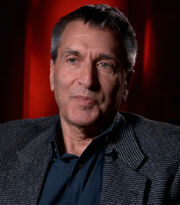
Nicholas Meyer
By now, pre-production had begun in earnest, and producer Robert Sallin and Mike Minor produced storyboards for the effects sequences. But, although this draft contained many, if not most of the elements of the final script, Bennett and Sallin were not satisfied. To their minds, the script did not have the epic sweep needed for a major film, so they called upon Samuel A. Peeples, who had written the original series' second pilot episode "Where No Man Has Gone Before". His script entirely omitted the character of Khan and replaced him with two powerful aliens called Sojin and Moray, who had been exiled from another dimension and possessed almost godlike abilities. While Peeples was working on the script, Bennett and Sallin found a director they liked in the form of Nicholas Meyer. A week or so before the last draft was due to be delivered, they met with him and promised they would be back in touch as soon as they had the new script in their hands. Meanwhile, time pressures were becoming critical and effects company Industrial Light & Magic told the producers that if they did not have a script within a matter of weeks, they would not be able to deliver the effects in time for the planned release date.
By the time the final Peeples draft arrived, Bennett and Sallin knew they could not film it. As Sallin explained: "We were off in some weird directions and I was really very concerned. It did not feel like a motion picture to me. Some of these ideas were too derivative and were too small in their scope. There wasn't anything underlying it. It was more about people shooting fire and things like that, as opposed to a real story."
Three weeks after their last meeting, Meyer called Bennett and asked where the script was. Although reluctant to share the script, which Bennett found almost embarrassing to share, Meyer persuaded him to send him the draft. Not impressed with what he had received, he called Bennett and told him and Bob Sallin to come up to his house with all the different drafts of the script. The three of them made a list of all the things from all the different drafts that they wanted to end up in the final film, and then Meyer set out to compile a screenplay that incorporated all those things. Meyer concentrated on crafting a strong narrative by getting all the scenes in the right order and putting the story into his own words. "I was only interested in cobbling together and cannibalizing various parts that seemed useful," he explained. "What I fall in love with is the story. I never looked at the scripts again, so there were no words that were appropriated. It all had to be in my own language and in a way that I could understand it."
Meyer had some very clear opinions about what made drama, and he was determined that, despite the futuristic setting, his film would make sense to a 20th century audience. Asked to quantify the character of his approach, Meyer produced two examples. The first was that he brought a sense of humor to the project, which is not to say that he did not treat it with proper respect. "I think that putting humor into a serious movie makes the serious stuff more serious, and the humor becomes more of an explosive release." The other important decision he made was actually something he thought about when Bennett and Sallin had first asked him to direct the film. "I had the haziest notion of what Star Trek was, because I didn't really watch the show on television. I finally latched on to the idea that Captain Kirk and friends were really an outer-space series of novels that I had loved as a kid, by C.S. Forrester, called 'Captain Horatio Hornblower'. So I said, 'OK, this is 'Hornblower' in outer space; I've got it.' When I wrote the script in 12 days it was very, very, very Navy, or, as my late wife used to say, 'Nautical but nice.'"
Casting
Because Ricardo Montalban had appeared on the original series episode "Space Seed", director Nicholas Meyer was not involved with casting him, though he certainly had no complaints. "Khan is enough to tell you that this is a great actor," he said. Most of Kirk's crew were in place, but Meyer was intimately involved with casting several new roles. He explained that what he was looking for was actors where he could see what the characters were feeling, even when they were not talking.
"For Carol Marcus I wanted a woman who was beautiful and looked like she could think; a woman who was attractive enough that you could see why Kirk would fall for her, and at the same time somebody who could keep up with him. [...] I loved Bibi Besch; I became very close with her, and I used her again in 'The Day After'. She's no longer alive and I bitterly regret it; she was a lovely human being, and a lovely actor."
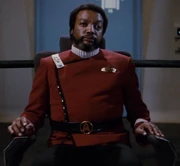
Paul Winfield as Captain Terrell
"Merritt Butrick is also tragically no longer alive. [As David Marcus] he not only had to be Kirk's son, he had to be Carol's son, so on a physical level I think what I liked was that his hair was the same color as hers but it was curly like Bill's, so I thought, 'Well, that's plausible.'"
"Paul Winfield was an actor I had wanted to work with since I saw 'Sounder', and I thought, 'Wow, what a lovely actor.' There was no real reason for him to be the captain of the Reliant, other than my great desire to direct him in scenes! I knew he could do it, without any question."
The biggest casting coup was giving a young Kirstie Alley the role of Saavik. "She said as a child she wanted to be Spock and that she was so in love with the role that she wore her ears to sleep. [...] She didn't have to find the role; she didn't have to work her way into it. She'd been living it somewhere in her head for years. There just wasn't a contest. I don't recall seeing another actor for that part who was as persuasive." In addition to her instinctive understanding of the role, Alley brought another, slightly more definable quality to her role. "The thing about her is that she's beautiful, but she also had a slightly other-worldly quality. [...] She was also able to encompass that sort of flat unemotionality, but she's basically a comedian. What I didn't know was that that flatness, like Leonard's, frequently comes out of a kind of a deadpan. I realized that when I watched her doing it. Then, at the other end of it, there she was at Spock's funeral, weeping. I remember somebody came running up to me and said, 'Are you going to let her do that?' And I said, 'Yeah', and they said, 'But Vulcans don't cry,' and I said, 'Well, that's what makes this such an interesting Vulcan.'"
Sets
When production designer Joseph Jennings reported for work on the second Star Trek film, he found the sets for the USS Enterprise still standing. After director Robert Wise had finished filming the first feature, he had simply closed the stage doors and moved on. In the intervening months, the interiors of the giant starship had sat patiently, waiting to go back into action.
Most of the action in the film takes place on the bridge of the Enterprise. Although the set may appear quite different from the bridge on The Motion Picture, Jennings only made cosmetic changes to the design. The layout remained the same, but in order to make the second film warmer than its predecessor, the set was repainted in darker colors.
Director Nicholas Meyer very much disliked the design of the Enterprise bridge set, because in his view there were many things that did not make sense: "[...] to take a silly example, if they are in terrible circumstances and everything gets all shook up, why don't they have seatbelts? And the answer is, because if they had seatbelts, it wouldn't be very interesting. Most of the movie actually takes place on that damn bridge, which is a very tedious set to photograph, and it was also, in a reconfigured form, the bridge of the Reliant, so I spent a lot of time there."
"The biggest problem was just keeping alive what is happening in a 360-degree world. The bridge was, very rightly, built in pie sections, so you could yank out sections and put the camera in. But, occasionally, you might want to be in the middle and sweep the camera around at what is going on. The sections are curved at the top, so when they are all in, how do you get light in there? It's a sort of a nightmare scenario. Gayne Rescher (director of photography) invented a lot of very peculiar apparatus that dropped in from the top with light coming off, like a big chandelier on a chain."
The Wrath of Khan did not have the budget to allow for significant alterations to be made to the bridge set, but Meyer did ask Jennings to find ways of making it appear more detailed and specific. "The least I thought we could do was revamp the bridge and make it twinkle. I remember I had Joe Jennings build me a wall of blinking lights. It was on wheels, and we would shove this thing around behind people, to try anything to break up this expanse of gray panel."
Director Nicholas Meyer insisted on a certain amount of 'business', so the art department built gratings into the floor of the torpedo room that had to be lifted before firing
Although several other sets were also still in place, the Enterprise still gave Jennings plenty of work to do. As he recalled: "A new script will call for different things; somebody walks down a corridor and goes into another room and, bang, you don't have that room, so you add it. And it grows [...] until the stage sort of bulges out."
The most obvious new addition was the torpedo room. Few people would realize it, but this set was actually a redressed version of the Klingon bridge from the first film. The torpedo room set featured a long channel where the torpedoes were loaded. Meyer wanted to have as much movement as possible in the action sequences, so he had Jennings put grates down over the channel that had to be lifted when the Enterprise went into battle.
The Enterprise bridge set was also adapted to serve as the bridge of the USS Reliant. "We had one thing going for us," said Jennings. "There's a great deal of similarity between the bridge of a destroyer and the bridge of a cruiser in the American Navy. We gave it a change of color and orientation, and we got rid of the big screen in front. As I recall, we changed some of the seating arrangements and the elevators a little bit, and, of course, we added the ceiling piece to it, because the beam had to come down and pin Ricardo to the floor. The whole ceiling piece was something that had never been featured in the bridge of the Enterprise. That gave it a different look."

This "Starfleet Headquarters" set used a perspective trick to appear much bigger than it really was
One of the non-starship sets Jennings worked on was an interior section of Starfleet Headquarters, where a brief scene shows Kirk walking out of the simulator and heading for an elevator. In reality, this set was much smaller than it appeared. Jennings explained: "Mike [Minor] had a bright idea; he went out to several hardware stores and came back with a birdbath, a planter, and a bunch of junk. He went off and fiddled with it for about two days, and he came up with a miniature. We put that in the foreground as what is called a 'cutting piece,' and the real set was in the background. They tied together visually and created a perspective trick that made the set look much bigger."

Kirk's apartment in San Francisco was filled with collectibles that demonstrated his interest in the past, including many nautical objects that Nicholas Meyer asked for
The next time we saw Kirk, he was in his apartment. Jennings had fond memories of this set, and said that the challenge was to make it clear that it was in San Francisco, but also show that it was a 23rd-century building. The setting was established by using a backdrop showing the Golden Gate Bridge that had been made for 'The Towering Inferno'. The next task, Jennings explained, was to make the room appear futuristic. "You set up your frame of reference, and then within that you've got to be honest, which will lend credibility to the physical aspects of your show. Like all architecture, it has to look as though it's possible to live in it; you look for materials, for instance, that are unfamiliar, or that are being used in an unfamiliar fashion, to make your design look different from what the public is seeing today."
Despite the need to make the apartment look futuristic, Meyer also impressed on the production crew that he doubted things would undergo a complete change in the future, so the apartment still had to look like a home. "A fireplace would be an anachronism but would still fit Kirk's image of having a cozy place to live," said Jennings, "so we had to make a fireplace that looked a little different; hence we used the curved wall and the mosaic treatment behind it." Meyer also wanted to suggest that Kirk had too much time on his hands in retirement and had a real attachment to the past, so Jennings and his team filled the set with antique collectibles.
However, Meyer was unhappy with the Genesis cave set, combining live footage with a matte painting. He thought that the scene looked fake and too constructed, and would've used a real location instead, but time and budget didn't allow it.
Costumes
When Robert Sallin came on board as producer for Star Trek II, one of the first things he did was change the wardrobe of the Starfleet officers. Sallin wanted the uniforms redesigned, yet, entirely due to budgetary reasons, he did not want to discard the old jumpsuits from the first Star Trek movie. "[...] so I said, 'Let's do some dye tests.' To this day, I have the swatches of the different-colored uniforms that we tested to see if we could reuse some of the old material and rework it."
The series of dye tests showed that the old uniforms would take three different colors well: a blue-gray, a gold, and a dark red. The plan was to use the modified uniforms for the junior cadets and enlisted crew, while enough money could be found to design an entirely new wardrobe for the senior officers.
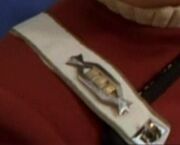
The departmental colors were preserved on the undershirts and on the rank insignia on the shoulder, although costume designer Robert Fletcher assigned new colors to each department
Director Nicholas Meyer had some very specific ideas about how the uniforms should look. "I decided that this was going to be 'Hornblower' in outer space, so I said, 'Okay, if this is going to be the Navy, let's have them look like the Navy; they shouldn't be walking around in pajamas,' which seemed to me to be what the uniforms in the first movie and the TV show looked like." Additionally, Meyer had one other, significant instruction for costume designer Robert Fletcher: he wanted the costumes to be reminiscent of the clothes worn in the film The Prisoner of Zenda.
Fletcher was careful not to reproduce any specific naval uniforms and used the dark red that had been discovered during the dye tests. Meyer was keen on this approach, since it made the costumes dramatic and created a strong contrast with the background. The first versions of the uniform had a stiff black collar like the costumes in The Prisoner of Zenda. Producer Robert Sallin suggested changing this into a turtleneck and, after he made the alterations, Fletcher decided to use trapunto, which is a form of vertical quilting. By 1981-82, the machines and specialized needles used to produce trapunto were exceedingly rare, and Fletcher was able to secure only one needle for the entire wardrobe department. Fletcher said: "That trapunto machine saved my life. The machines are very rare and are not made anymore. We had, perhaps, the only one in existence on the West Coast, a 50-year-old antique. We lived in constant fear that we were going to break its one and only needle, because, of course, you can't get them anymore either." One day, Fletcher genuinely worried that the needle had been lost or stolen (and even entertained thoughts of it being held for ransom) when one of the department's workers had taken it home as a security measure.
Meyer had always wanted the uniforms to feel as real as possible, and thus asked for rank insignia. Fletcher explained: "There was kind of a complicated arrangement of divisions and ranks expressed by the braid on the sleeves. I made that up. I organized it and produced a little instruction booklet about it for the wardrobe department [...]." On the early version of the uniforms, the insignia were on a band around the upper arm, which was later moved to the cuff. The last major change was to redesign the flap of the double-breasted jacket so that it would actually open. This was something Meyer wanted, because he felt the lighter color on the inside of the flap would frame the actors' faces better.
The flaps, however, did present Fletcher with a problem: when they were open, one could clearly see the snaps that held it in place, and, as he says, these looked distinctly unfuturistic. "In order to make these look less like plain old snaps, I found this sterling silver chain that looked strange. I ordered a reel of it and sewed it in with the snaps to give it a feeling that it was perhaps a magnetic closing."
For Khan and his followers, Fletcher wanted to create a definite contrast with the highly organized Starfleet uniforms. As he explained, his idea was that their costumes were made out of whatever they could find. "My intention with Khan was to express the fact that they had been marooned on that planet with no technical infrastructure, so they had to cannibalize from the spaceship whatever they used or wore. Therefore, I tried to make it look as if they had dressed themselves out of pieces of upholstery and electrical equipment that composed the ship." After Khan and his followers hijack the Reliant, many of them (including Khan himself in one scene) are seen wearing the stolen Starfleet uniforms of the Reliant crew as open jackets (with Khan wearing one of Terrell's as the captain's rank insignia is prominently featured).
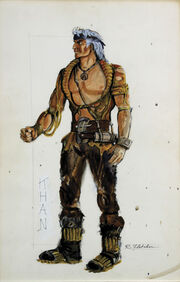
Ricardo Montalban's costume was designed to expose as much of his chest and arms as possible
He added that when it came to Khan's costume, there was another major consideration. "We wanted to show Ricardo Mantalban's physique. He was rather proud of it, as he should have been. That was a theatrical gesture." Of course, when Khan first appears he is dressed from head to foot in rags. Again, Fletcher said, the design of this costume was dictated by Khan's situation. "They had to protect themselves from the planet, which was very inhospitable. That was the origin for the kind of Bedouin look. If you have nothing else, and you have access to some fabric you may have ripped out of a bedroom or whatever, then you wrap yourself up to protect yourself from the sandstorm."
For the remaining costumes, Fletcher's biggest concern was to create a sense of contrast with the major outfits. Carol Marcus and her team were given white smocks that suggested futuristic lab coats and, in the scene where Kirk and McCoy are dressed in civilian clothes, Fletcher tried his best to make sure the outfits looked practical and comfortable. Amusingly, Fletcher said the one costume that he got asked about most made only a fleeting appearance in the film. When Kirk visits Spock in his quarters, the Vulcan is wearing the same robes he wore in the previous movie. "People always ask me what the writing on front of Spock's black velvet, at-home costume symbolize. I have to explain the language that I invented to decorate those things, and I can't! All I can say is that it's very akin to Chinese; it's non-syllabic, and the various shapes contain an entire thought and you don't use them to make words."
He added that most of the costumes feature what he described as "corrupt" colors. "Technically, they are colors that are a little bit tinged with their complements. Probably, the closest thing in art history is art deco colors. I once did a production of Offenbach's Voyage to the Moon, and I based that on the fact that the moon probably looked like an art deco world. Maybe that struck in my mind, because I used those colors here." He added that because these colors are not quite true, there is something slightly odd about them, which gives the audience the feeling they are from a different world.
The casual wear worn by William Shatner as Kirk was auctioned off in the It's A Wrap! sale and auction on eBay.
Shooting

Sallin insisted that Kirk's first appearance was as dramatic as possible. He wanted a shot when Kirk was silhouetted by the light behind him, and when the first version was not powerful enough, he had it reshot
At the opening of the film, Robert Sallin wanted to make the entry of Kirk as dramatic as possible. He explained: "[...] we're introducing Captain Kirk. I think we need a little drama here, so here's what I want to do. When those doors open, the room is filled with smoke, and I want him to emerge in silhouette. I want the strongest backlight you can give him, directly behind him, so that when he walks through there are fingers of light that surround him in the smoke. I want it to look like the Second Coming." The original version shot was not powerful enough for Sallin, so he made sure that it was reshot.
Sallin found a way of giving Meyer this shot of a torpedo without having to rebuild the set
During Spock's funeral scene, director Nicholas Meyer wanted the camera to be directly in front of the torpedo that acted as a coffin and to move with it as it slid into the launcher. "I [Robert Sallin] got a call from the head of production at Paramount: 'Nick [Meyer] wants this, and we're going to have to rip out the floor, and we're going to have to rebuild the set so it's high enough off the ground to get the camera in. We've got to talk to Nick.' We all went down there, and everyone was gathered around looking at this through. I just turned to the key grip and said, 'Do you have a Western dolly?' That's basically a trolley that you use to pull the camera. He said, 'Yes,' and I said, 'Have you that tubular track for it? And can you put on the little wheels?' He nodded, and I said, 'Can't we mount the camera on the dolly, put the track down inside the trough, then move the camera with an offset arm [which allows one to control it from above] and do the shot that way?' He said, 'Yeah, we can do that,' and I said, 'What's that going to cost?' and he said, 'About $30,' and I said, 'Well, I think that's what we're doing, then!'"
Visual Effects
The visual effects for The Wrath of Khan were filmed quickly and efficiently – and, most importantly, they came in on budget. Unlike the first Star Trek feature, the effects were produced by Industrial Light & Magic, a company which would come to dominate the industry in the coming decades. Producer Robert Sallin recalled ILM's approach to the project: "They were incredible. The most professional, the most delightful, the most responsive; I couldn't say enough good things about the whole crew. It was an amazing experience."

The Regula I space station
As a sequel, Star Trek II was able to reuse most of the models that had already been built for The Motion Picture. Besides the Enterprise model, Sallin wanted to make use of the orbital office complex that Kirk beamed up to in the first film; it became the Regula I spacestation. Steve Gawley, head of the model shop at the time, recalled: "We took it [the orbital office model] apart and put it upside down and then reattached some of the outer pods in a different way."
The remaining model shots required entirely new models. The ILM team built the Regula planetoid and several other simple pieces, but the main task was the construction of the Reliant, which was the first Starfleet vessel other than the Constitution-class ever seen. Paramount's art department provided the model builders with detailed drawings to work from, and, as modelmaker Bill George remembered, a general instruction that the Enterprise and Reliant should look as different from one another as possible. "The one thing that was a little bit different on the drawings was that they had come up with a totally new color scheme for the graphics, thinking that would make it look different. [...] When I got them in, I said, 'This can't happen.' So I showed them to Kenneth Ralston [ILM supervisor to the film]. His take on it was, 'Let's put on the Federation graphics we've seen before, and see what they say.' Thankfully, the producers were happy with it."
The biggest challenge the ILM team faced was showing the heavy damage that the Enterprise and Reliant inflicted on each other in the script. The model shop used several different approaches to make sure that they did not actually have to damage the models. On the Enterprise, the damage was essentially cosmetic; pieces of aluminum were added on which were tainted so that, where need be, the damage could literally be peeled off. The damage to the Reliant was much more serious, so larger versions of different parts of the ship were built that could be destroyed.
The initial confrontation ended with the destruction of a dome toward the rear of Reliant's saucer. After that came the biggest single effects sequence of the film – the Battle of the Mutara Nebula. To create the nebula, the team used a cloud tank, which is basically a large container with colored liquid in it. The team spent weeks shooting the tank, searching for shots that could be used as background for the epic battle. When everything was finished, the team sat down to look through all their footage for shots they could use with the models.
Reliant inflicts severe damage to the Enterprise
Once the nebula had been filmed, the team focused on the starships that would be moving around inside it. Because the ships were often in the distance, the team was able to use small versions of the models which were much easier to handle than the full-size models and could perform bigger maneuvers. In one of the most impressive scenes of the battle, the Reliant fires its phasers at the Enterprise's "neck" section, cutting an enormous gash in the process. This shot was created using traditional stop animation techniques. Kenneth Ralston explained: "I had that section done as a wax piece and then painted it to look like the ship. Obviously, we worked out exactly how the camera was going to move. Then I just went into the wax version, and I would take little sculpting tools and rip stuff up and bend it around. We'd film that, then the camera would move whatever distance it would cover in one frame, and I'd sculpt some more damage. Then, on top of that, we did some animation of a laser hit sort of cutting into it, but it left a real cut – a big scar [...]."

Reliant's nacelle blown off
The damage brought onto the Reliant was even more severe, and involved making several separate sections. "One of the engine pods blows up," remembered Ralston. "We couldn't blow up the whole pod for some reason, so I built a shape similar to it and it was more like glass blowing out of the warp nacelle. We shot that as a separate element and then printed that on top of the actual model for the Reliant, with other pieces blowing off of it. Then, when the whole nacelle blows off, that was just a bunch of explosions and a separate arm that we shot using motion control."
Perhaps the most important visual effect in the film in terms of historical significance is the Genesis Effect. This is the first use of particle effects in a motion picture. Particle effects are now widely used.
Notes
- This movie was the first Star Trek release to occur in the 1980s.
- The Wrath of Khan, the second Star Trek feature film installment, is traditionally regarded by fans as the best in the series, and considered by many non-fans as an excellent science-fiction picture. The film earned US$14,347,221 at the US box office in its opening weekend, a record at the time, which was broken two years later by Indiana Jones and the Temple of Doom (which in turn was outgrossed by the next film in the series, The Search for Spock).
| Movie trailer |
- When the film first appeared in theaters in June of 1982, the opening credits listed the movie simply as Star Trek: The Wrath of Khan. This was also done for the official movie novelization. Subsequent prints of the film retitled it Star Trek II: The Wrath of Khan.
- According to William Shatner's Star Trek Movie Memories, the original title of the film was The Undiscovered Country, the undiscovered country in this case, being death. According to Shatner and Nicholas Meyer, Meyer was outraged when Paramount changed the title of the movie to The Vengeance of Khan without consulting him. Meyer said that the title was ridiculous and that they wouldn't be allowed to keep it with George Lucas making a movie called Revenge of the Jedi at the same time. Then because of that, Paramount changed the title to The Wrath of Khan and Meyer hated that even worse, but was made to live with it although it became a moot point when Lucas changed the title of his movie to Return of the Jedi.
- Many of the outer space scenes in the first half of the movie are reused from Star Trek: The Motion Picture. These include the Klingon battle cruisers in the Kobayashi Maru sequence, the shots of the travel pod, the Enterprise's departure from drydock, and its first jump to warp speed.
- Khan's apparent recognition of Chekov and his remark "I never forget a face," are somewhat ironic, since Khan's appearance in TOS: "Space Seed" was in the first season and Chekov did not make his first appearance until Star Trek's second season. It is possible, however, that Chekov was on the Enterprise at the time and Khan had seen him off screen. In fact, as noted on the Special Edition DVD's text commentary, Walter Koenig often joked (at conventions and in interviews) that his character had made Khan wait overly long to use a bathroom on Khan's visit to the Enterprise and that was why Khan remembered his face so well.
- Greg Cox's non-canon novel To Reign In Hell established that Chekov was a security officer at the time of this episode and he led the security team that escorted Khan and his people down to Ceti Alpha V. He also led an assault against Khan and his followers to retake engineering but were forced back.
- In his DVD commentary track, director Meyer said that he was aware of the discontinuity but ignored it. Meyer acknowledged that he could have just as easily put Uhura on the Reliant and keep the consistency, but he preferred Chekov and referenced the fact that Sir Arthur Conan Doyle frequently contradicted himself in his books about Sherlock Holmes, saying that the continuity doesn't matter, as long as he has the audience engrossed in and enjoying the story.
- McCoy's line "He's really not dead, as long as we remember him." was improvised by Nicholas Meyer during filming, after he read an article on the set, concerning the possibility of Raoul Wallenberg being alive. Referring to Wallenberg, Simon Wiesenthal said in the article, "He's really not dead, as long as we remember him." (Star Trek II: The Wrath of Khan DVD Audio Commentary)
- No visitors were allowed on the set during the filming of Spock's death, keeping it a secret as much as possible. Nicholas Meyer remembered, when they shot the scene, he looked around and saw members of the crew, including cinematographer Gayne Rescher crying, and did not understand their reason for bursting into tears. It was much later, he admitted, when he understood the significance of that scene. (Star Trek II: The Wrath of Khan DVD Audio Commentary)
- The events of the film were novelized by Vonda N. McIntyre and adapted into a photostory by Richard J. Anobile.
- In the years since this movie, when he would be asked about Khan, Ricardo Montalban would compare how he played the character both times. In the original episode he presented Khan as a powerful but well-disciplined leader for his people. But when it came time for the movie, he incorporated the fact that Khan's wife, Marla McGivers (from the episode), had died during their exile, and showed Khan having turned into an obsessively vengeful man whose chance at revenge against Kirk had arrived.
- In other various interviews at the time of the movie and afterward, some of which can be seen on the Star Trek II DVD features disc, Montalban has also spoken about how he almost turned the role down as he wanted a rather substantial part after coming off of six years of Fantasy Island. Montalban changed his mind when he read the script and realized that the other characters were talking about Khan even when he wasn't on screen and so it made the part seem even more substantial. Montalban also recalled about when he first started reading the script after having accepted the role and trying to articulate Khan that to his horror, he sounded like Mr. Roarke and was terrified that the audiences would laugh at him and so Montalban contacted Harve Bennett and requested a tape of "Space Seed" and after several viewings of the episode Montalban began to recall how he had played Khan and the mindset and attitude he used with the character originally and was much more comfortable afterward.
- Ricardo Montalban also said in promo interviews for the movie (and can be seen on the Star Trek II DVD set) about how he realized early on in his career that a good villain does not see himself as villianous. He may do villianous things, but the character feels that he is doing them for righteous reasons. Likewise, with heroes, Montalban said he always tried to find a flaw in the character because no one is completely good or completely evil. He then compared Khan to this, saying that while Khan had a rather distorted view of reality and therefore comes the villainous acts, he still feels that his acts of vengeance against Kirk is a noble cause because of the death of his wife whom he loved dearly.
- At a high level, the characters of Khan and Kirk can be seen, respectively, as Captain Ahab and the great white whale from Herman Melville's novel Moby Dick (which was found among Khan's possessions). Khan quoted several lines from the novel almost exactly (even down to his dying curse). The ambiguous allegorical nature of the novel was not reproduced in the film, however. The original series episodes "Obsession" and "The Doomsday Machine" and the TNG film Star Trek: First Contact were also inspired by Melville's novel.
- As with Star Trek: The Motion Picture, Paramount filed for and obtained design patents on some of the costumes, props (including the Ceti eel), and ships from this film.
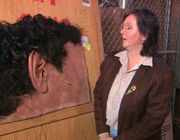
Juday with the recreation of Chekov's ear.
- The special effects scene in which the ceti eel got into Chekov's ear was filmed with a large recreation of the ear on a plate. The model which was used was later put in storage and was shown by Penny Juday in the special feature "Inside Starfleet Archives" on the TNG Season 2 DVD.
- Star Trek Nemesis had plot and even music elements similar to this film.
- The pre-launch background dialog overheard on the bridge as Kirk and McCoy arrive is almost identical to the checklist overheard in Main Engineering before the Enterprise launches in Star Trek: The Motion Picture.
- Since Kirk's birthdate was established in Federation computer records in the Star Trek: Enterprise episode "In a Mirror, Darkly, Part II" to be March 22nd, this means that the beginning of this film is set on March 22nd, 2285.
- This is the only TOS movie in which a ship fires its phasers. All other films in the TOS series have the ships firing photon torpedoes. The next film in the series to have a ship fire its phasers was in Star Trek Generations twelve years later.
- Kirk and Khan do not meet face to face in the entire film; all of their communication is done using viewscreens and communicators.
- This was the fourth of five Star Trek projects to be adapted into View-Master reels.
- The film was nominated for a Hugo Award for "Best Dramatic Presentation." It was also nominated for eight Saturn Awards, winning two; "Best Actor" (William Shatner) and "Best Director" (Nicholas Meyer). In 2003, it was nominated for a further Saturn Award for "Best DVD Classic Film Release."
- Later in the Trek franchise, there are two scenes where a crew is preparing for battle like the Enterprise crew does here. The first is in VOY: "Scorpion", as Voyager prepares to enter Borg space. The other time is in Star Trek Nemesis when Captain Jean-Luc Picard's crew readies the USS Enterprise-E ahead of their confrontation with Shinzon's ship the Scimitar.
- This film marks the first appearance in the Star Trek franchise of an isolation door in main engineering. It can be seen lowering during the "surprise attack" sequence following Khan's hijacking of the Reliant. That door later became the shuttlebay door on the Enterprise-D.
- There is a "No Smoking" sign on the door of the simulator room during the Kobayashi Maru test. It only appears in the earliest part of the scene. According to Mike Okuda's DVD commentary, it was removed at the request of Gene Roddenberry, who did not envision smoking as part of the Human lifestyle of Star Trek's future. Nevertheless, St. John Talbot was seen lighting up in Star Trek V: The Final Frontier.
Merchandise gallery
Video and DVD releases
- US Betamax release: 1982.
Appendices
Credits
- All credits
- Uncredited Cast
- Laura Banks as Khan's navigator
- Pam Bennett as Khan's woman [1]
- Steve Bond as Khan's henchman
- Fletcher Bryant as Khan's henchman
- Todd Bryant as an engineering cadet
- Brett Baxter Clark as Khan's henchman
- Tim Culbertson as Khan's henchman
- Richard Forinash as an Enterprise lieutenant
- John Gibson as Khan's henchman
- James Horner as an Enterprise training officer
- Dennis Landry as Khan's henchman
- Cristian Letelier as an engineering cadet
- Jeff McBride as Khan's henchman
- Roger Menache as Khan's henchman
- Nanci Rogers as Khan's henchwoman
- Kimberly Ryusaki as an Trainee Enterprise crewmember
- Judson Scott as Joachim
- Deney Terrio as Khan's henchman
- Philip Weyland as an Enterprise crewman
- Daniel Wong as an engineering cadet in sickbay [2]
- Unknown performers as
- Uncredited Production Staff
- Nicholas Meyer, Writer (screenplay)
- Samuel A. Peeples, Writer (story, additional writing material)
- Lightning Bear, Stunts
- Emil Richards, Percussionist
- Marvin Hoar, Video Operator
- Ed Moskowitz, Video Operator
- Jim Padgett, Video Operator
- The Producers Acknowledge the Invaluable Assistance of Bjo Trimble and Samuel A. Peeples in All Matters Relating to Star Trek
References
19th century; 2267; 2283; 2284; Administrative Offices; allergy; Altair VI (Altair system); Armageddon; Amazing Grace; Antares maelstrom; Arakelian, D.; bagpipes; Becker, M.; Bellus; Bible; bionetics; birthday; blue shift; boatswain's whistle; Boy Scouts; bridge; bridge (card game); Ceti Alpha; Ceti Alpha system; Ceti Alpha V; Ceti Alpha VI; Ceti eel; chambers coil; checkers; Christmas tree; class D; Cole, L.; comm-pic; Copenhagen Base; craylon gas; crewman; Dante; Dante's Inferno; doppler compensator; dynoscanner; Einstein, Albert; Enterprise, USS; Enterprise-class; Excellency; FEDSCBU; fire extinguisher; Fletcher, R.; funeral; Gabrielle, D.; Gamma Hydra; Gamma Hydra sector; Genesis Device; Genesis Planet; geoplastics; Gluck, D.; Gort; Graffeo, C.; gravitic mine; gravitronics; Grodnick, T.; Henry, A.; intruder alert; James T. Kirk's San Francisco apartment; JBK sensors synthostasis; Jennings, J.R.; Template:ShipClass, katra; King Lear; Klingons; Klingon Neutral Zone; Kobayashi Maru; Kobayashi Maru scenario; Kosygin Base; K'ushui; log buoy; Longo, J.; main stage flux chamber; Maltese, D.; marksman; medical tricorder; midshipman; Mark III bridge simulator; Mark IV bridge simulator; Mark X bridge simulator; McGivers, Marla; Minor, M.C.; model; Neutronic fuel carrier; Moby Dick; mooring; Mutara Nebula; Mutara Nebula, Battle of the; Oomaru; Paradise Lost; Paradise Regained; phaser emitter; type 2 phaser; photon torpedo; plastics; preanimate matter; prefix code; prestage flux chamber; Project Genesis; radiation poisoning; Rescher, G.; redshift; Regula; Regula I; Reliant, USS; Retinax V; rigor mortis; Romulans; Romulan ale; sailing ship; senility;Shaandra; ship's bell; Sofak; Stran; Starfleet Corps of Engineers; Starfleet General Orders; Surak; tactical situation monitor; Tale of Two Cities, A; Talos III; Tau Ceti; Tau Ceti IV; Thelonii; Tiberian bat; thermonics; thermowave multiplexer; travel pod 05; tricorder; Tyche Laboratories; Vulcan; Vulcan language; Wise, D.; Wong, J.; Xanthi; Xon; Yaan; Zyra
Sources
- Star Trek: The Magazine, September 2002, volume 3, issue 05.
- The Art of Star Trek, Judith, Garfield Reeves-Stevens, Pocket Books, 1995.
- Star Trek II: The Wrath of Khan The Director's Edition
- Anderson, Kay. "Star Trek: The Wrath of Khan, How the TV Series Became A Hit Movie, At Last," Cinefantastique Magazine, volume 12, issues 5-6 (double issue) spring 1982
External links
- Star Trek II: The Wrath of Khan at StarTrek.com
- Star Trek II: The Wrath of Khan at Wikipedia
- Template:IMDb-link
- Template:NCwiki-title
| Previous Movie: Star Trek: The Motion Picture |
Star Trek Movies | Next Movie: Star Trek III: The Search for Spock |

